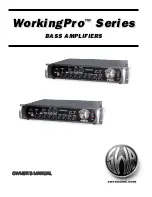
✧
s
s w
w r
r s
s o
o u
u n
n d
d .
. c
c o
o m
m
✧
✧
s
s w
w r
r s
s o
o u
u n
n d
d .
. c
c o
o m
m
✧
5
E. AURAL ENHANCER - Featured on just about every
SWR
®
amplifier since the company’s inception in
1984, it is a trademark part of the “SWR Sound”
people have come to know and love. It was developed
to bring out the fundamental low notes of the bass
guitar, enhance the high-end transients, and reduce
certain frequencies that “mask” the fundamentals.
The ultimate results are: 1. A more transparent sound,
especially noticeable when slapping and popping, and
2. Passive basses take on an “active” type of quality
when set at “2 o’clock” or positions further clockwise.
How the AURAL ENHANCER works: Think of it as a
variable tone curve that changes depending on where
you set the AURAL ENHANCER control knob. As you
rotate the control clockwise from the “MIN” position,
you are elevating low–, mid–, and high–frequency
points selected specifically because they’re different
than those of the individual Tone Controls.
This remains true up to about the “2 o’clock” position.
This position—a favorite for many users—brings out
both the low end fundamentals and crisp highs and, at
the same time, adds a little lower midrange to help cut
through the band. However, if you go further
clockwise and past the “2 o’clock” position, selected
mids will start to drop off—specifically, a group of
frequencies centered around 200 Hz. At this point and
after, the effect becomes much more pronounced.
However, the curves involved here are gentle, as
opposed to the very extreme curves you can create by
boosting or cutting the Active Tone Controls (EQ).
Most significantly for basses, the AURAL ENHANCER
will help bring out the fundamentals of your lower
registers without masking them with overtones, as is
possible when using the BASS control only. At the
same time, it opens up the sibilance characteristics of
all instruments without being harsh.
Your ears are the best judge when it comes to settings
that affect the tone of your instrument. Obviously,
“numbers, curves and circuits” mean nothing if not
heard with your own ears. So, play a chord, a
repeated lick, or a harmonic, and turn the AURAL
ENHANCER control to various points on the knob to
hear the effect for yourself.
F.
BASS - Employs a shelving-type circuit that boosts or
cuts low-frequencies (±15dB), from about 30Hz to
100Hz, centered at around 80Hz.
G.
MIDRANGE SEMI-PARAMETRIC EQ -
You have two midrange tone controls.
MID LEVEL boosts or cuts (±15dB) the
level of midrange response at the specific
midrange frequency selected by the
MID FREQ knob. To find a midrange
frequency, rotate MID LEVEL fully to either “–15” or
“+15” (this makes frequency changes more
noticeable). Adjust MID FREQ to the specific
frequency, then adjust MID LEVEL as desired.
NOTE: When MID LEVEL is in the center (12 o’clock)
position, the midrange semi-parametric equalizer is
“flat” and has no effect on your signal regardless of
the position of the MID FREQ control.
TIPS: If you need to “cut through” the band a little
more, try boosting the 200–400Hz midrange
frequency level. If you like a more transparent or
“scooped” sound, try cutting the 800Hz midrange
frequency level. The midrange controls are especially
useful in controlling fretless basses and their inherent
qualities.
H. TREBLE - Employs a shelving-type circuit that boosts
or cuts high-frequencies (and their subsequent
octaves ±15dB) from about 2 kHz to 14 kHz.
I.
TRANSPARENCY - Boosts or cuts ultra-high
frequencies (±15dB) above ~5kHz.
J.
EFX BLEND - Controls how apparent your effects
loop sounds, or more precisely, the ratio of external
effects loop (wet) signal, to internal amplifier (dry)
signal. Used in conjunction with the rear panel Effects
Loop jacks, EFX BLEND is enabled when a 1/4" phone
plug is inserted into EFFECTS RETURN {S}.
F
F
F
F
r
r
r
r
o
o
o
o
n
n
n
n
tt
tt
P
P
P
P
a
a
a
a
n
n
n
n
e
e
e
e
ll
ll
—continued



























